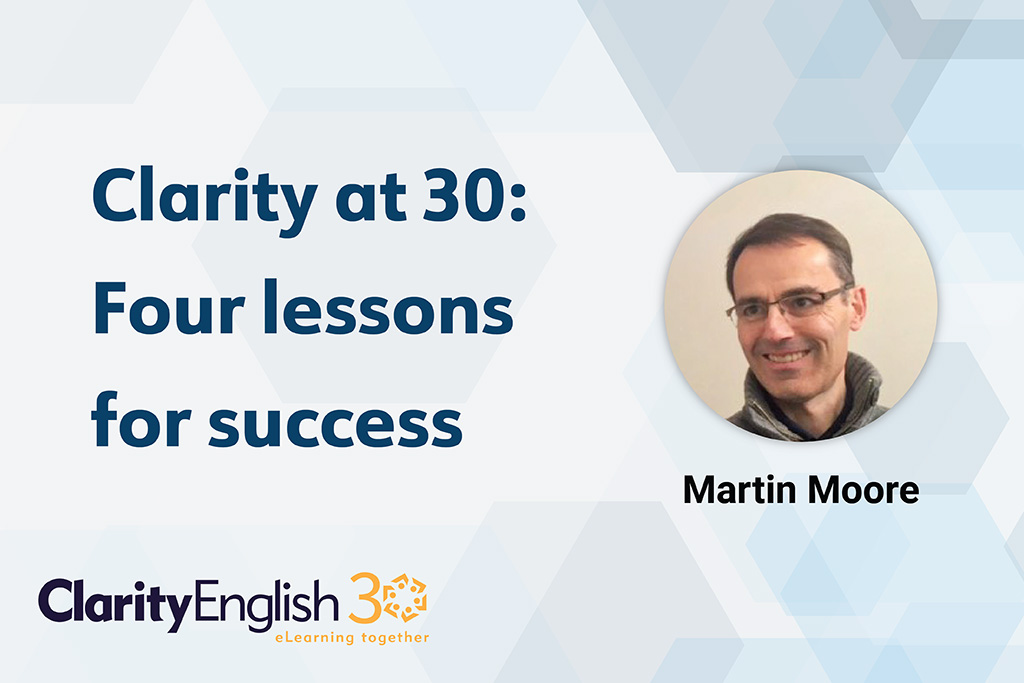Martin Moore has 30 years’ experience as a publisher, writer and editor. He has worked for Cambridge University Press, Pearson, BBC English and Oxford University Press.
In 1992 I was a junior editor working for one of the leading ELT publishers. A friend of mine wrote me a letter (yes, there was a time before email) asking my advice about setting up a company to publish language-learning software. Experience with digital was limited in those days. All I’d seen was my company struggling with the marketing of a handful of discs. Not many people understood the creative process, sales were very modest but more than anything else, the after-sales support was a nightmare. If the customer couldn’t get the disc to work (and that was a common scenario, for many reasons), no one knew how to help them. The result was that people put the disc back in its case and either returned it to the publisher or left it on their shelf. My advice to my friend was: you don’t want to get involved in this. Fortunately, he knew better and went ahead with his plans to set up ClarityEnglish.
In the intervening 30 years, digital has gone from a niche activity to finally being a core part of the ELT publishing industry. It hasn’t, however, been a smooth or a fast journey – and we’ve all had to learn as we go. But among the many lessons I’ve learned along the way, here are four:
1. Get your technical support right.
One of the reasons why Clarity confounded my pessimistic prediction is that they put technical support at the heart of the company. If there’s one thing that has remained constant throughout the long digital revolution, it’s the importance of reliable technology backed up by dedicated support. It doesn’t matter how good your content is if your product is unreliable or hard to use. This has been confirmed in the last two years during the Covid pandemic. In the middle of a crisis, when schools suddenly needed digital resources to work remotely, they wanted platforms and tools that they could rely on and use with minimum training. So they turned to digital specialists, whether small companies like Clarity or tech giants like Google and Microsoft.
2. Give technology and pedagogy equal priority.
In recent years, we’ve seen the explosion of EdTech start-ups, with ambitious young entrepreneurs chasing technology investment. Far too many put the clever technology first and then bolt on outdated ideas about language learning. On the flip side, the traditional publishers hold the pedagogical expertise but are often overambitious about what they think they can develop technologically. The best digital publishers have an equal understanding of education and technology. The only route to success is knowing what teachers and students need and knowing how to deliver it through technology.
3. Understand creativity.
Some teachers and publishers have been surprisingly resistant to digital, on the grounds that digital products are less ‘creative’ because they have to fit defined templates. But this ignores two crucial things. Firstly, there’s the creativity of the technology itself – automated scoring, instant feedback, intuitive use, easy access to multiple media, the ability to use the same product on different devices… all the things that can’t be done in a traditional book. And secondly, the way we consume information online is different from the way we read textbooks or magazines. It’s no longer the variety of design that counts, but the variety and range of content – interesting articles to read, realistic audio to listen to, and engaging videos to watch.
4. Digital is a specialism.
If you’re a teacher or a learner of English, you can choose to use both paper and digital products. The big ELT publishers know this and have tried to add digital on to their traditional print business. But the truth is… the ways of creating, delivering and marketing digital and print products are very different. If you’re a specialist digital publisher and depend entirely on the success or failure of your digital products, you soon learn the hard lessons of what works and what doesn’t. But if you’re one of the big publishers, whose revenue continues to come from your print business, it’s hard to fully commit to digital publishing. In the end, there’s no shortcut to replicating the expertise that comes from building and running a successful digital business over 30 years.
The so-called digital revolution has brought some amazing opportunities for language learners. So much English-language content is accessible at the tap of a finger, and it’s quick and convenient to practise. But if there’s one more reason for ClarityEnglish’s success over 30 years, it has been their understanding that some things stay exactly the same. To learn a language, you need to practise reading, listening, speaking and writing. You have to learn some grammar and vocabulary. And you’ll probably have to do some tests. Digital doesn’t change any of that. It’s simply a way of facilitating the process.

